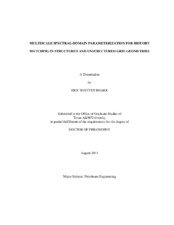| dc.description.abstract | Reservoir model calibration to production data, also known as history matching, is an essential tool for the prediction of fluid displacement patterns and related decisions concerning reservoir management and field development. The history matching of high resolution geologic models is, however, known to define an ill-posed inverse problem such that the solution of geologic heterogeneity is always non-unique and potentially unstable. A common approach to improving ill-posedness is to parameterize the estimable geologic model components, imposing a type of regularization that exploits geologic continuity by explicitly or implicitly grouping similar properties while retaining at least the minimum heterogeneity resolution required to reproduce the data. This dissertation develops novel methods of model parameterization within the class of techniques based on a linear transformation.
Three principal research contributions are made in this dissertation. First is the development of an adaptive multiscale history matching formulation in the frequency domain using the discrete cosine parameterization. Geologic model calibration is performed by its sequential refinement to a spatial scale sufficient to match the data. The approach enables improvement in solution non-uniqueness and stability, and further balances model and data resolution as determined by a parameter identifiability metric. Second, a model-independent parameterization based on grid connectivity information is developed as a generalization of the cosine parameterization for applicability to generic grid geometries. The parameterization relates the spatial reservoir parameters to the modal shapes or harmonics of the grid on which they are defined, merging with a Fourier analysis in special cases (i.e., for rectangular grid cells of constant dimensions), and enabling a multiscale calibration of the reservoir model in the spectral domain. Third, a model-dependent parameterization is developed to combine grid connectivity with prior geologic information within a spectral domain representation. The resulting parameterization is capable of reducing geologic models while imposing prior heterogeneity on the calibrated model using the adaptive multiscale workflow.
In addition to methodological developments of the parameterization methods, an important consideration in this dissertation is their applicability to field scale reservoir models with varying levels of prior geologic complexity on par with current industry standards. | en |


